
Starfish or sea stars are star-shaped echinoderms belonging to the class Asteroidea. Common usage frequently finds these names being also applied to ophiuroids, which are correctly referred to as brittle stars or basket stars. Starfish are also known as asteroids due to being in the class Asteroidea. About 1,900 species of starfish live on the seabed in all the world's oceans, from warm, tropical zones to frigid, polar regions. They are found from the intertidal zone down to abyssal depths, at 6,000 m (20,000 ft) below the surface.

Asterias is a genus of the Asteriidae family of sea stars. It includes several of the best-known species of sea stars, including the (Atlantic) common starfish, Asterias rubens, and the northern Pacific seastar, Asterias amurensis. The genus contains a total of eight species in all. All species have five arms and are native to shallow oceanic areas of cold to temperate parts of the Holarctic. These starfish have planktonic larvae. Asterias amurensis is an invasive species in Australia and can in some years become a pest in the Japanese mariculture industry.
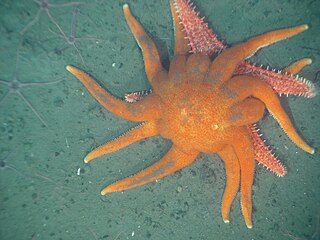
The Valvatida are an order of starfish in the class Asteroidea, which contains 695 species in 172 genera in 17 families.
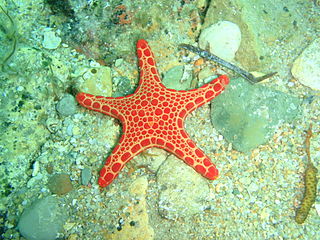
Goniasteridae constitute the largest family of sea stars, included in the order Valvatida. They are mostly deep-dwelling species, but the family also include several colorful shallow tropical species.

Culcita is a genus of sea stars. They are found in tropical waters. Some are kept in home aquariums.
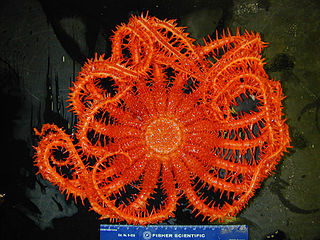
The Brisingids are deep-sea-dwelling starfish in the order Brisingida.

Hippasteria is one of 70 genera of sea stars in the diverse family Goniasteridae.

Fromia is a genus of starfish belonging to the family Goniasteridae.
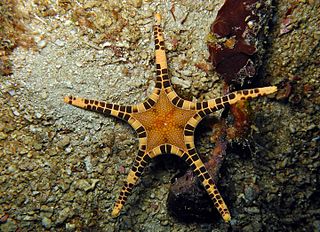
Iconaster longimanus, the icon star or double star, is a species of starfish in the family Goniasteridae. It is found in the west and central Indo-Pacific Ocean. The genus name comes from the Greek eikon, meaning portrait or image and possibly referring to the way the marginal plates frame the disc, and aster, meaning star. The specific name comes from the Latin longus manus and refers to the long, slender arms.

The Zoroasteridae are one of three families of Asteroidea in the order Forcipulatida. It contains seven living genera and one extinct genus.
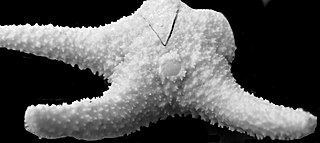
Bathyporania ascendens is a species of starfish in the family Poraniidae, and the only species of the genus Bathyporania. It is native to the Pacific Ocean and is found in deep water off the coast of North America.

Evoplosoma is a genus of deep-sea sea star in the family Goniasteridae.

Circeaster is a genus of abyssal sea stars in the family Goniasteridae.
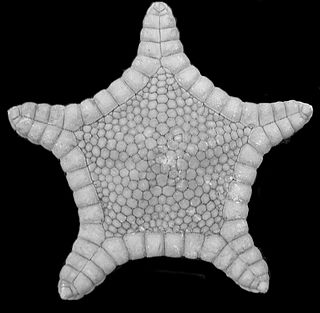
Astroceramus is a genus of abyssal sea stars in the family Goniasteridae.

Apollonaster is a genus of abyssal sea stars in the family Goniasteridae. They can be identified by their bare abactinal plate surfaces and multiple accessory granule rows on their abactinal plates. To date, Apollonaster has been found in the tropical Atlantic region and Hawaiian Islands region oceans, with no other locations or species being known as of 2015.

Hippasteria muscipula is one of twelve species of deep-sea sea star in the genus Hippasteria, which is in the family Goniasteridae.
Evoplosoma claguei is a species of deep sea corallivores. This species in particular is found in seamounts in the North Pacific.
Evoplosoma voratus is a species of deep sea corallivores. This species in particular is found in seamounts in the North Pacific.

Apollonaster kelleyi is a species of abyssal sea star within the family Goniasteridae, that was discovered in 2015 in the Hawaiian region. It is identified as part of the Apollonaster genus based on its bare abactinal plate surfaces and multiple accessory granule rows on its abactinal plates. The species name kelleyi was chosen in honor of Dr. Christopher Kelley, director of the Hawaii Undersea Research Laboratory.

Rathbunaster is a monospecific genus of sea stars in the family Asteriidae. The genus name was given by Walter Kenrick Fisher to honor the starfish biologist Richard Rathbun of the Smithsonian Institution. He originally ranged this genus under the family Pycnopididae, synonymous with Asteriidae.
















